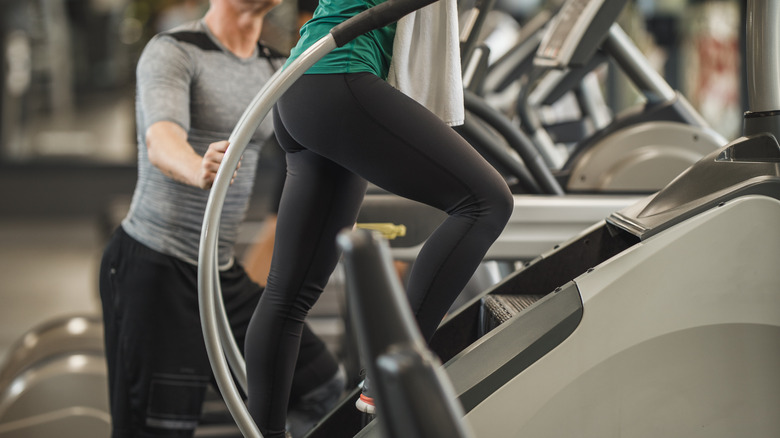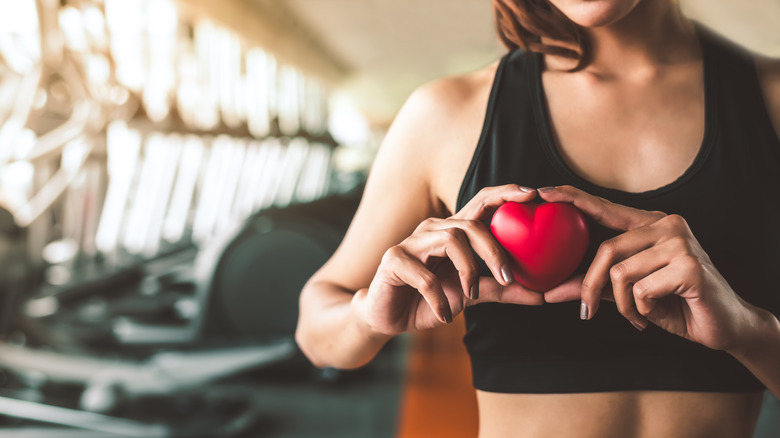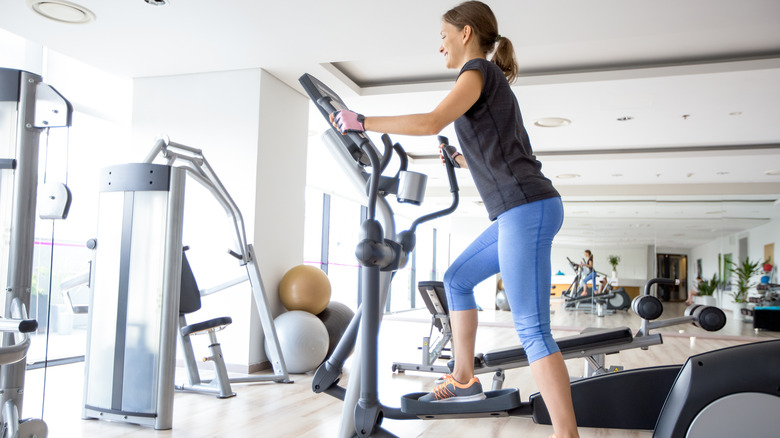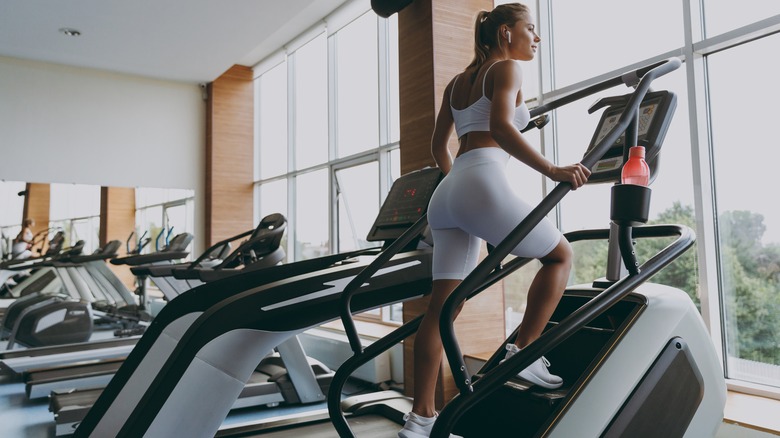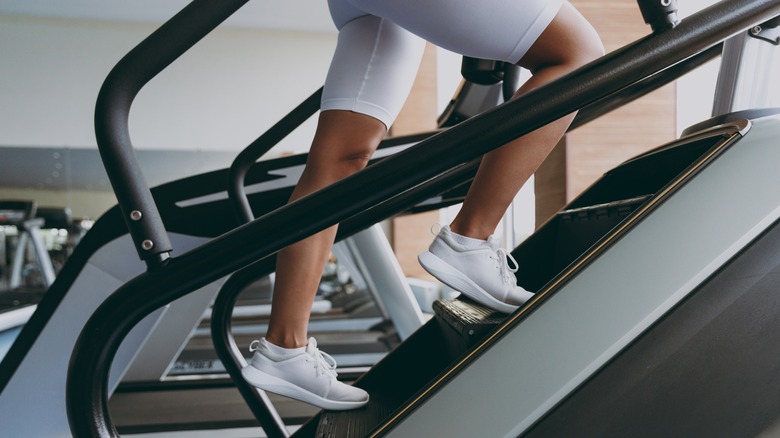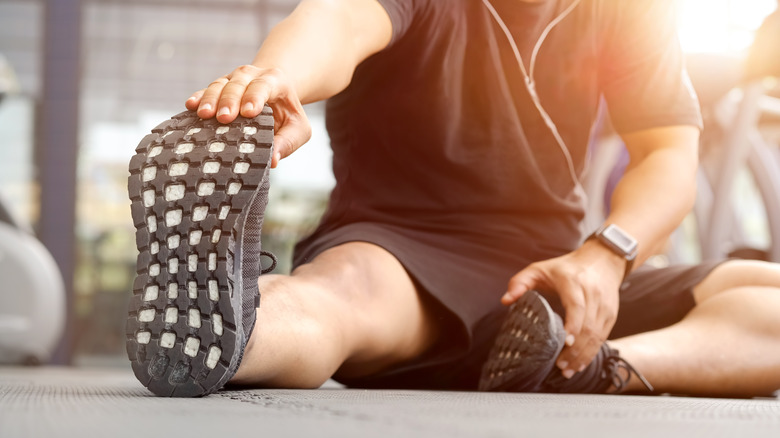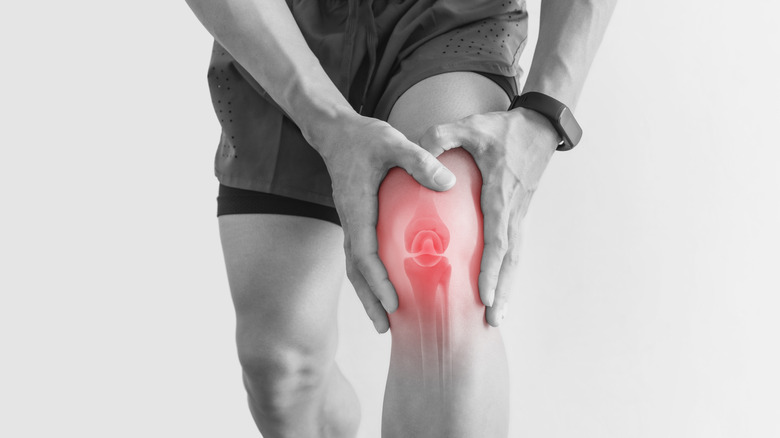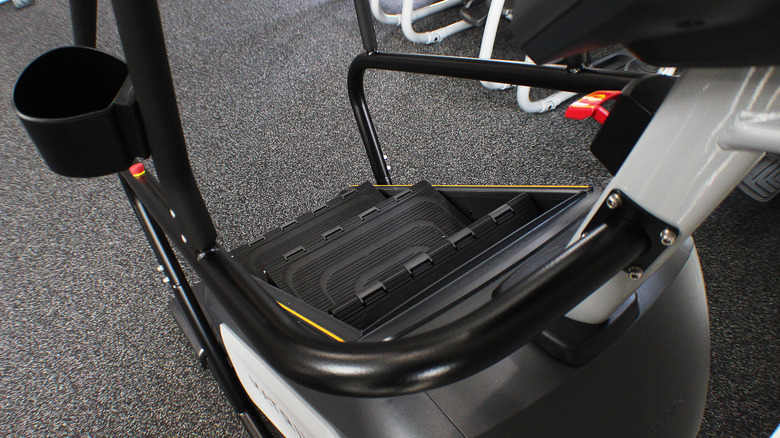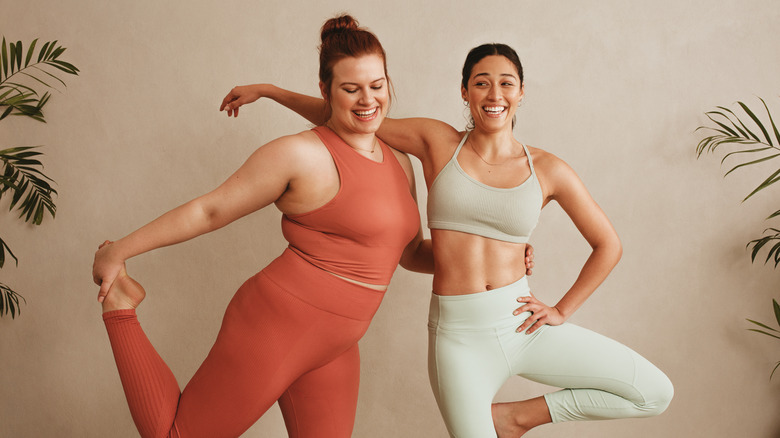The Real Benefits Of Using A StairMaster
The StairMaster is one of those gym machines you might walk right past on your way to the treadmill without even giving it a glance. Its tall, bulky shape may look intimidating and complicated, but the benefits it can offer make the climbing cardio machine worth a try.
The stair climb is a low-impact natural movement, meaning that it's easier on the knees, ankles, and back than some other exercises and almost anyone can do it (via Aaptiv). The machine offers a plethora of settings, for beginners to the more advanced. They're equipped with various programs like steady state cardio and high intensity interval training (HIIT).
The StairMaster can burn a ton of calories, offering an incredible cardio workout, but what makes this machine an even bigger gym win is the toning and shaping it can offer your lower body (per Livestrong). The more you utilize the step machine in your workouts, the stronger and leaner your quads, hamstrings, calves, and glutes will become.
Celebrity trainer Adam Friedman tells Shape that you can target certain areas of your body when using the StairMaster by making subtle changes, such as taking two steps at a time. He states "By taking big, giant steps, you'll target the glutes and the upper thighs, where the mass of muscle is."
How the StairMaster helps your heart
The benefits of using the StairMaster are not only limited to the ways it can shape and strengthen your lower body. According to Healthline, stair climbing can help keep your heart and lungs strong due to its aerobic conditioning. A healthier heart can pump more oxygen-rich blood through the body while stronger lungs allow more oxygen into it.
Harvard Health Publishing reports that stair climbing, when compared to walking, burns twice the number of calories. This can lead to a reduced risk of obesity, a factor closely correlated with the risk of heart disease. Dr. JoAnne Foody, medical director of cardiovascular wellness services at Harvard-affiliated Brigham and Women's Hospital, says "Stair climbing reduces the risk for heart disease by lowering blood pressure and cholesterol, reducing stress levels, and aiding in achieving or maintaining a healthy weight."
For optimum heart health, the American Heart Association recommends at least 150 minutes per week of moderate-intensity aerobic exercise or 75 minutes per week of more vigorous cardio spread throughout the week, with muscle-strengthening at least two days a week. The StairMaster is a great choice to meet these requirements, with its versatility for cardiovascular exercise as well as its strength training properties.
StairMasters give your body a serious cardio workout, with your muscles benefitting too
Anyone who's ever climbed up multiple flights of stairs (on moving day, visiting a friend in an apartment block with no elevator, fleeing from a secret agent in an action-movie sequence) knows the unique combination of a pumping heart and on-fire thighs it gives you. That's because stair climbing, as emulated by StairMasters, provides an incredible cardio workout by using the large muscles in your legs and posterior, according to Prevention. Using a StairMaster gets your heart pumping, says trainer for Aaptiv Candace Cunningham, and can help build a strong foundation for cardiovascular fitness and further exercise (per Aaptiv). And by constantly activating and testing your leg muscles, you'll also get some serious toning going on.
Due to the StairMaster's particular customizability for your workouts, it's also easy to switch up your speed and intensity to really skyrocket your cardio benefits, contributing to your stamina, endurance, and heart health, advises Cunningham. If you're using a StairMaster for cardio specifically, try your best not to get into a rut of stepping at the same speed, says Men's Journal, as switching up your intensity generally takes the edge on fitness over steady-state cardio.
StairMaster workouts can be short and effective
For some reason, StairMasters tend to get overlooked in the fitness speediness stakes; why climb the stairs when you can do a quick HIIT workout, right? Well in actual fact, StairMaster workouts can be incredibly effective in just a short space of time — a 30-minute session can help give you a great cardio workout, as Healthline points out, and can burn the same amount of calories in half an hour as activities like swimming or aerobics (per Harvard Health Publishing). And aiming for 30 minutes of moderate use of a StairMaster five times a week will keep you in line with the Department of Health and Human Services guidelines for exercise (via the Mayo Clinic), recommended to help you live an active and healthy lifestyle.
But what if you don't have that long? Well, folks, the StairMaster has you covered there too. Remember that quick HIIT workout we mentioned before? That can be achieved on your StairMaster machine, with a 20-minute HIIT sequence designed by Lion and Luxe studio owner and NASM-certified personal trainer Brent Bareham that'll not only get your blood pumping, but will also test your coordination and balance (via Daily Burn). With a combination of lateral walks, double-steps, and high-effort forward walking, you'll be feeling the burn and saving time.
StairMasters can help you burn through energy fast
Using the StairMaster machine may seem like a deceptively gentle mode of exercise, but trust us, you can burn through a lot of energy using them. For thirty minutes of use, a StairMaster can have you expending anything between 180 to 252 calories, according to Harvard Health Publishing. That's roughly the same amount of energy you'll burn doing activities like dancing, hiking, downhill skiing, or wrestling — not bad for a humble gym machine. It's worth pointing out that this energy expenditure is dependent on a few factors, such as your body weight and your workout intensity, with more calories being burned the faster you set your machine.
If you want to keep track of exactly how much energy you're burning, most StairMasters have built-in calculators to help you see your estimated calories lost, says Healthline. And if you really want to ramp up your calorie burn, simple adjustments like climbing without using the handrails or taking bigger steps can help. Certified strength and conditioning specialist Chris Ryan also suggests monitoring your heart rate during a StairMaster workout, and aiming to keep it elevated. "You will release a greater amount of overall calories operating at 80 percent or above of your max heart rate through excess post oxygen consumption (EPOC effect) than you will operating in a low heart rate state for your work intervals," Ryan states to Aaptiv.
StairMasters may help you lose overall fat
If your fitness goals include losing fat, then a StairMaster could help. Using a StairMaster machine will supply you with a strong aerobic workout and a good calorie expenditure, and over time, the continued exertion applied can lead to fat loss, says Livestrong. This is aided by the muscle-strengthening benefits that a StairMaster can supply to your lower body, as more overall muscle leads to a higher metabolism. It's important to remember, however, that fat loss does not necessarily come as a result of working out on its own, but through creating a calorie deficit via a combination of exercise and diet that means that you're burning more calories than you're taking in.
Equally as useful to bear in mind is that fat loss, when it happens, occurs from the entire body, not just one place at a time, writes certified strength and conditioning specialist Tom Kelso for Breaking Muscle. The idea that you can lose fat in a single area, like around your abs (also known as "spot reduction"), is a myth, and the StairMaster will instead help you reduce your total body fat percentage when combined with creating a calorie deficit. There are ways, however, to adapt your workout so that certain muscles in your body are targeted. Using a combination of balance-challenging exercises, like side-steps and backward climbs, will help activate your core muscles and build strength in the area, according to Fitplan.
StairMasters can be as beneficial as running
When it comes to cardio workouts, running is the go-to for millions of people every day. We can understand that: It feels like nothing could be simpler for a quick bit of exercise than lacing up your shoes and going for a jog. Apart from, perhaps, climbing stairs — and as it turns out, using a StairMaster isn't just as simple as running, but it's as beneficial too. Both running and StairMaster workouts are aerobic-based and, depending on the intensity of your exercise, have comparable calorie expenditures for the same amount of time, points out Livestrong. Both treadmills and StairMasters can help you burn almost 400 calories in just half an hour, although the amount of calories you use will be massively affected by how much effort you put in during this time.
Where StairMasters may have the edge on running, though, is in the potential toning benefits to your lower body. "A StairMaster is good for someone who wants to focus on building the butt," says personal trainer Stephanie Mansour to Today. "As you climb the stairs, you have to activate your quads and your glutes because you're moving up and therefore engaging the back of the leg and glutes." Those who have joint conditions, however, should be cautious if considering using a StairMaster, as the climbing motion can place stress on the knees.
StairMasters can help tone your lower body muscles
Ever climbed up a long flight of stairs and realized that your lower body was quite literally on fire? That's because when we do this activity, our muscles are being challenged — and doing this over and over again on a StairMaster can help our lower body muscles get strong fast. "Just like squats can build our muscles for standing up effectively from sitting down, or lifting heavy objects — Stairmasters help us to build strength and endurance in the muscles we use to climb stairs and walk uphill," says personal trainer Jenny Francis-Townson to Tom's Guide. When we repeatedly place stress on our muscles through exercise, they break down and rebuild stronger, leading to increased tone and mass (per Medical News Today).
Among the muscles targeted when using a StairMaster are your quadriceps and hamstrings (the larger muscles in your thighs), your calf muscles, and your glutes, aka your butt, according to Healthline. Your calf muscles are particularly well-activated during a StairMaster workout by your heel having to lift to take each step, and your thigh muscles through the force needed to propel your body up to the next step.
Using a StairMaster instead of an elliptical may impact your lower body more
StairMasters and ellipticals are often viewed as bedfellows in the gym, as two cardio machines that are simple and quick to use. And more likely than not, you'll already have a preference, but we're here to break down the pros and cons of each. Although both machines will help get your heart racing, for people who are trying to avoid impact-related workouts, the elliptical may be your best option. "Because they're non-weight bearing, ellipticals offer the lowest impact option compared to treadmills and StairMasters. The machine's low-impact, continual gliding motion is the gentlest of them all, making it fantastic for folks recovering from knee or hip injuries," advises nutritional counselor and NSCA-certified personal trainer John Fawkes to My Fitness Pal.
Interestingly, however, that lack of impact when using an elliptical means that certain muscles may not be being worked out as fully. Compared to the elliptical's set range of motion, the StairMaster has your body moving more organically, and this can activate the smaller stabilizing muscles used to help you keep balance, says exercise physiologist Todd Buckingham via My Fitness Pal. Training your stabilizer muscles can help improve your posture and alignment, and reduce your risk of sustaining injuries during exercise, says O.S.R. Physical Therapy.
Using weights during a StairMaster workout can help target your upper body
While StairMasters will help your lower body tone up fast and your cardiovascular fitness improve, that isn't all they're good for. By incorporating weights into your StairMaster routine, you can also get your upper-body muscles involved and achieve a full-body blast with maximum efficiency. Simply pick up a pair of dumbbells and take them over to the StairMaster with you in the gym, suggests Shape.
Doing upper-body exercises like overhead shoulder presses or bicep curls while your lower body is stepping will help your upper-body tone up simultaneously. And not only that, but it'll also increase the effort exerted by your body and the overall weight you're having to lift as you step up, increasing the amount your cardiovascular system has to work, according to California-based trainer Adam Friedman. Just make sure that when using weights, you're not going too fast on the StairMaster machine — you want to take things slow and keep it controlled. Be mindful of using weights that are too heavy, too. It can be tempting to assume that lighter weights aren't as effective as heavier ones, but it's all about how much effort you put in. As research published in the Journal of Applied Physiology shows, using lighter weights for more reps can be as effective for working your muscles as heavy weights lifted fewer times.
Using a StairMaster could help improve your mood
Okay, sure. Climbing up stairs endlessly may not be many people's idea of fun. But you might just find that after a session on your StairMaster you're feeling a little bit brighter, thanks to the exercise's potent effects on mood. "The link between exercise and mood is pretty strong. Usually within five minutes after moderate exercise you get a mood-enhancement effect," states Boston University professor of psychology Michael Otto to the American Psychological Association (APA), pointing toward the endorphin release that accompanies exercise as what makes us feel so good (per WebMD).
And while exercise may well put a smile on your face in the short term, it may also help your mental health over a longer period. James Blumenthal, a clinical psychologist working at Duke University, notes to the APA the strong link between regular physical activity and reduced incidences of depression and potential management of anxiety. Despite this, it should be pointed out that exercise should not be considered a substitute for any existing treatment for mental health conditions you might be undergoing.
StairMasters may help your bones and joints get stronger
In the U.S. alone, almost a quarter of all adults experience some form of joint pain, according to a report published by the Centers for Disease Control and Prevention (and discussed via WebMD). Finding ways to protect our joint and bone health throughout our lives can help minimize the risk of issues later down the line, and thankfully StairMaster training is particularly well-suited to this.
As a weight-bearing exercise, StairMaster training places a certain amount of pressure on our joints and bones. Often, this is far from a bad thing. "Some stress on your bones and joints is good," advises NSCA-certified personal trainer John Fawkes to My Fitness Pal. He adds, "Our bones are just like muscles, where if you stress them, they will adapt and get stronger. Performing solely non-weight bearing exercise could potentially decrease your bone density and put you at risk for osteoporosis." One thing to remember, though, is that if you have joint or bone issues already, this could have the opposite effect. The increased stress that stair climbing places on the knee joint mean that it can exacerbate joint issues, so if you already have joint problems, low-impact exercises should be prioritized (per Livestrong).
StairMaster workouts can be adapted to target lower-body muscles more specifically
Your StairMaster workout will already give your lower body a pretty great workout. But as with many exercises, stair climbing can become a little repetitive, and if you're doing the same workout every time, you might see your gains suffering. "Fitness improvements are dependent on the body adapting to handle a new training stimulus," says Memorial University of Newfoundland David G. Behm to Self. "Once it adapts to handle a stimulus, it doesn't have the need to adapt any further," he adds.
But by mixing up your StairMaster workouts, you can not only keep your muscles challenged but target specific muscles in your legs and lower body to make sure every base is being covered. All it takes is a few step variations. Instead of walking up straight-on, try taking sideways steps, crossing your legs over as you do so, recommends ACE-certified personal trainer Candy Morales to Popsugar. That'll help build both your outer and inner thighs. You can also throw in a leg extension between each step to help target your hamstrings and glutes, and keep your muscles challenged.
An efficient StairMaster workout can be done in just over 10 minutes
In the endlessly quickening pace of day-to-day life, it can feel like exercise is one thing that you can't speed up. To a large extent, that's true: Results from exercise are based on consistent, long-term effort, as the National Institute for Fitness & Sport states. But if you're strapped for time when you'd normally be exercising, hopping on the StairMaster can still help you get your sweat on, and a super-efficient workout can be achieved on the machine in just 11 minutes, as Tom's Guide shows. Suitable to perform at most fitness levels, start by warming up with regular steps for two minutes, and then cycle through side-steps, high-knee climbs, and rear-leg lifts for 15-30 seconds at a time, increasing the levels of the StairMaster as you go. Finish by performing a cool-down for one minute.
And if you have a little more time to work out, your StairMaster is the perfect machine to help you get warmed up, with just five minutes on the machine preparing your muscles for other exercises, says Aaptiv master trainer John Thornhill to Well+Good. Using weights while you warm up and throwing in some bicep curls, overhead presses, and tricep kickbacks can also help your upper body get prepared.
The benefits of using a StairMaster will increase if you're using them correctly
So, it's pretty clear that a StairMaster is a pretty darn good way to get a good workout. But as with any other gym machine out there (and if we're being real, any other form of exercise at all), executing your workout correctly is crucial. With a StairMaster, there are a few key pitfalls that'll reduce the efficacy of your workout, and potentially increase your risk of injury. Keeping an eye on your posture is the first step. "When you're hunched over, you're putting strain on your back and turning down your glutes," warns California-based personal trainer Adam Friedman to Shape. Make sure you're keeping your spine straight, and if you are bending forward, do so at the hips.
Furthermore, don't get too tempted by the rails on the side. Although they can help with stability, relying on them too heavily will stop you from getting the most out of your exercise. "That's not helping your body work harder — it's cheating," Friedman states (via Shape). Should you need to balance yourself, holding the rails lightly can help, but putting too much weight on them will take the full effort out of your legs.

